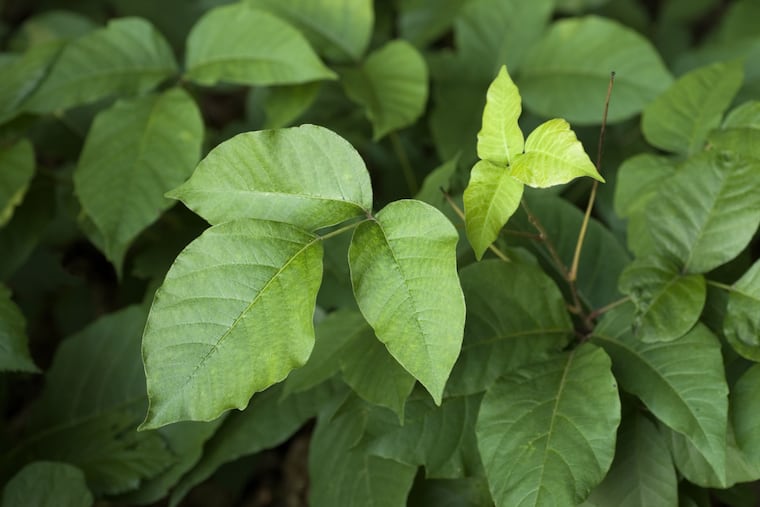How to recognize poison ivy, poison oak, and poison sumac
The three-leafed menaces look alike, but you can prevent the itchy rash that comes with contact by learning what they look like and how to protect yourself.

The old saying goes: “Leaves of three, let them be.” Poison ivy, poison oak and poison sumac are three plants that carry the same toxin — urushiol, a colorless, odorless oil that causes an itchy, irritating rash. While they differ in appearance, all these plants grow white, cream, or yellow berries in the fall.
Here is how you can tell these plants apart:
Poison ivy (A) usually has three broad, tear-shaped leaves. It can grow as a climbing or low-spreading vine that sprawls through grass. It is found everywhere in the United States except Alaska and Hawaii. It often grows along rivers, lakefronts, and ocean beaches.
Poison oak (B) has leaves that look like oak leaves and grows as a vine or a shrub. The plant can have three or more leaflets per group. It is most common in the western United States.
Poison sumac (C) has seven to 13 leaflets per stem that are characterized by smooth surfaces and pointed tips. It is most often found in wooded, moist areas of the southern United States.
Symptoms
You can develop a rash by touching poison ivy, poison oak, or poison sumac — and by transfer of the oil from someone or something (such as a dog or clothes) that has come in contact with the oil. The rash is very itchy and uncomfortable, but it is not contagious. Touching the skin of an affected individual will not cause you to get the rash, as long as the oil has been washed off.
The body's allergic response to the plant toxins may not be apparent for several days and differs in severity from person to person. The skin will become red and swollen, and then blisters will appear. After a few days, the blisters will become crusty and start to flake off. Healing can take anywhere from one to two weeks.
Treatment
After contact with poison ivy, poison oak or sumac, immediately wash the exposed areas thoroughly with soap and water. Initially, hosing off outside or showering is preferred over a bath to minimize contact of the oil with other parts of the body.
It is very important to wash all clothes and shoes immediately after exposure because the oils can remain on them and cause reinfection.
If a rash develops, there are several things you can try to relieve the itching:
Take a bath with colloidal oatmeal. Colloidal oatmeal is oatmeal ground to a powder so that it can evenly disperse in water. You can buy it from the pharmacy or make your own by grinding up dry oatmeal in a blender.
Wet a washcloth with warm water and place it on the affected area.
Apply calamine lotion to the affected area.
Consider a steroid cream (hydrocortisone) if itching persists. Be careful not to get it in your child’s eyes and mouth.
Consider oral antihistamines (diphenhydramine), especially if itching interferes with sleep. Consult your pediatrician if dosing is not listed on the package for your child’s age/weight.
It’s important to try to keep the itching under control because lots of scratching can increase damage to the skin and increase your child’s risk of developing a skin infection.
Call your doctor if your child has a rash on the eyes, mouth, or genitals. Seek immediate medical attention for severe reactions, especially those resulting in swollen eyes or face and/or difficulty swallowing or breathing. Your child may need oral or intravenous steroids (prednisone) and possibly a medication (epinephrine) to treat severe allergic reactions.
Most allergic reactions will clear up in 14 to 21 days. However, if the symptoms persist or worsen, contact your child’s pediatrician for further treatment.
Prevention
Avoid areas where you know the plants live.
Wear long sleeves and long pants if exploring wooded areas where you might find one of the plants.
Show your children pictures of the plants so they learn what they look like.
Let your children know that they should avoid touching the plants.
Don’t burn the plants – urushiol can be released in the air and can cause breathing problems in addition to skin reactions.
Visit the Poison Control Center’s website to learn more about poison ivy, oak and sumac, and other plants that irritate.
Jeanette Trella, PharmD, BCPPS, is a Residency Preceptor with the Pharmacy Residency Program and the Managing Director of the Poison Control Center at Children’s Hospital of Philadelphia.